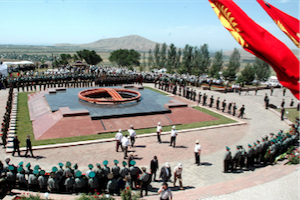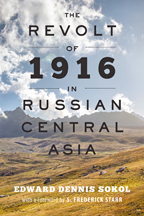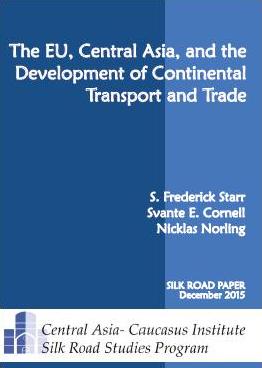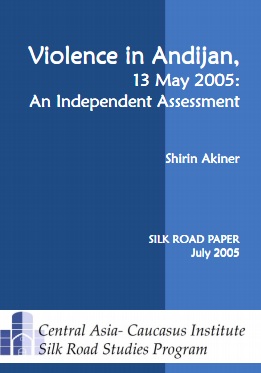Revolt in Central Asia: The Cataclysm of 1916

Revolt in Central Asia:
The Cataclysm of 1916
Wednesday, June 8, 2016, from 5 to 7 p.m.
(reception at 5 p.m., followed by the main program at 5:30)
A century ago, at the time of World War I, hundreds of thousands of Central Asians – Kazakhs, Tajiks, Turkmen, Uzbeks, and above all Kyrgyz – perished when they revolted against the tsarist Russian government's attempt to draft them into the army. Besides those who were killed outright, tens of thousands of Kyrgyz men, women, and children died trying to escape over treacherous mountain passes into China.
Soviet authorities have long suppressed Information on the 1916 revolt, but its Centennial has generated fresh interest, marked by seminars, mass meetings, and publications. Russia, in the meantime, has closed relevant archives and offered the curious thesis that the revolt was actually directed not against Russian rule, but against the authority wielded by the indigenous Turkic bourgeoisie.
The Central Asia-Caucasus Institute marks the centennial of the tragic loss of Central Asian life with two major publications: a new edition of the book The Revolt of 1916 in Russian Central Asia by Edward Dennis Sokol, with foreword by Dr. S. Frederick Starr (JHU Press); and a Silk Road Paper entitled Central Asia in Revolt: the Cataclysm of 1916, edited by Zamira Sydykova. Both of these publications will be presented and discussed at this forum.
This event can now be viewed on the SAIS Events YouTube channel.
Speakers will include:
Zamira Sydykova, Ambassador, Editor in Chief, Res Publica Newspaper
Dr. Prof. Mirzokhid Rakhimov, Visiting Fulbright scholar at Central Asia-Caucasus Institute/Head of the Dept. for Contemporary History and International Relations, Institute of History, Academy of Sciences, Uzbekistan.
Moderator: S. Frederick Starr, Chairman, Central Asia-Caucasus Institute.
Rome Building Auditorium
SAIS - Johns Hopkins University
1619 Massachusetts Ave., NW
Washington, DC 20036
Click here to RSVP and register
The Revolt of 1916 in Russian Central Asia
Edward Dennis Sokol, with a foreword by S. Frederick Starr
Paperback, 208 pages, 1 map
ISBN:9781421420509
May 2016
Follow this link to order a copy of the book
The EU, Central Asia, and the Development of Continental Transport and Trade
Violence in Andijan, 13 May 2005: An Independent Assessment
By Shirin Akiner
Silk Road Paper
July 2005
I was the co-director of a NATO Advanced Research Workshop (ARW) on “Global Security Challenges in Central Asia: Impact of Aggressive Religious Extremism and Terrorism on Central Asian States”, to be held in Tashkent 26-28 May 2005. The event was aborted on 18 May, following the decision of NATO Council to ‘postpone indefinitely’ this undertaking. The decision was taken in reaction to reports of violence in Andijan on 13 May.
Canceling the project at this late stage meant that there were organizational details which had to be resolved in person. Accordingly, I went to Tashkent 21-29 May (using the air ticket that had been purchased previously) to attend to these matters. When I was in Tashkent, I made time to visit Andijan. This report is based on my findings there.
My main reason for going to Andijan was to try to understand what had happened on 13 May, as I found the media reports confusing and inconsistent. I had good access in Andijan and was able to visit important locations (e.g. hospital, prison, cemeteries) and to speak to a wide range of people. I do not pretend to have definitive answers, but my tentative conclusions are as follows:
o The death toll was probably closer to the government estimate (i.e. under 200 deaths) than to the high estimates (1,000 and above) given in media reports.
o The action was initiated by armed, trained insurgents, some of whom came from outside Uzbekistan.
I did not find indications that the action was driven by religious or socioeconomic demands. It seems likely that the motive was political, intended as the opening phase of a coup d’état, on the lines of the Kyrgyz model. The choice of 13 May was, I believe, significant: it was a Friday, the main day of public prayer, and the insurgents appear to have believed that they could rally popular support by linking their action to a religious cause, underlined by the freeing of imprisoned members of the banned Islamist Akromiya movement. This did not in fact happen. I suspect that this incident was not an isolated occurrence, but part of a power struggle that will continue for some time to come.
The international reaction to the Andijan violence was largely shaped by sensational media reports which portrayed the incident as the deliberate massacre of innocent civilians. Very little mention was made of the fact that the insurgents were armed and that they had quite clearly planned the event as a military operation.
In Uzbekistan, some people supported the condemnation of the government by Western sources, but others (from a variety of backgrounds) felt that it was unjustified and opportunistic. It is likely that Uzbekistan will now review its foreign policy priorities. The result will probably be greater emphasis on relations with Russia and China, possibly also with other countries such as Iran and India. It seems likely, too, that participation in the Shanghai Cooperation Organization will receive new impetus. Internally there will probably be a crackdown on human rights activists and NGOs.





